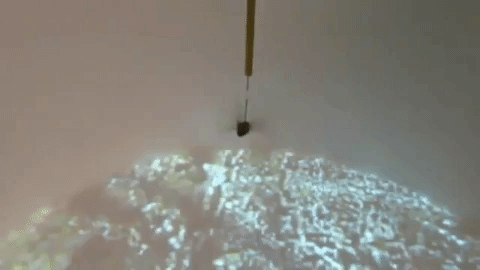What if you had to find your way through hundreds of miles of unknown territory with only your eyes and a simple compass to guide you? That’s what the Australian Bogong moth does in its annual migration, flying over 600 miles (roughly 30 million times its body length) to seek a haven from summer heat in the cool caves of the Australian Alps.
An international team of researchers announced in the journal Current Biology that Bogong moths rely on a magnetic sense as well as vision to steer its flight path. This makes them the first nocturnal insect we know of that can sense the Earth’s magnetic field — and maybe use it to guide their seasonal odyssey, joining a sophisticated club of birds, sea turtles, and fish.
Move Over, Monarchs
Several moth varieties fly long distances during their migrations, but Bogong moths are the only insect other than Monarch butterflies who travel from a broad geographical area to gather in a specific spot. For the flashy Monarchs, that’s a warm winter getaway in Mexico called the Monarch Butterfly Biosphere Reserve, a UNESCO World Heritage Site and popular tourist destination. For the humble Bogongs, it’s a summer home in a remote set of caves in the Australian Alps.
“This particular species is interesting because we know exactly where they’re going,” says David Dreyer, a research fellow at the University of Lund, Sweden with expertise in neuroethology — the study of animal brains and behavior. He and Eric Warrant, a professor and neuroethologist also at the University of Lund, conducted much of the study.
Knowing the moths’ migration direction was key to the experimental design. When Dreyer and the team captured moths along their migration routes, they could be sure of which way the moths were headed — south toward the Australian Alps in the spring, north in the fall. If the moths were using a magnetic sense to navigate, captured moths in an artificial setup might similarly prefer to fly toward magnetic south or north poles, depending on when they were caught.

The researchers collected Bogong moth test subjects using a light trap, a.k.a. a Bat-Signal-like searchlight, white sheets, and jars. “We call it the Eye of Sauron,” says Warrant of the powerful searchlight. (Credit: Eric Warrant)
Eric Warrant
A Flight Simulator for Moths
The researchers tested the moths in a specialized flight simulator their colleagues had invented to study the migration of Monarch butterflies. They attached moths to long shafts that let them turn in any horizontal direction and which constantly logged the moths’ flight direction. Around each moth they placed a cylindrical plastic barrier, bare except for a few simple shapes as visual landmarks, and a magnetic coil that mimicked the Earth’s magnetic field.
Finally, to actually get the moths to cooperate and fly in this artificial setup, the researchers projected satellite images of the surrounding countryside onto a surface below the moth, following the direction of movement and simulating a natural moving landscape.
When the researchers kept the visual landmarks and magnetic field direction aligned, the moths consistently flew toward the landmarks, making corrections to their flight path when the landmarks and magnetic field were moved. However, when the researchers turned the magnetic field so it was now at a different angle relative to the visual cues, the moths became disoriented and flew in random directions. When the magnetic field and landmarks were returned to the original setup, the moths once again flew consistently toward the landmarks.

A Bogong moth flying in the flight simulator. (Credit: Eric Warrant)
Eric Warrant
Because the moths became disoriented when the magnetic field didn’t agree with what they were seeing, the researchers conclude that Bogong moths are definitely able to sense magnetic fields, and that they seem to use a combination of magnetic senses and vision to steer their flying. It’s a step further to say that Bogong moths use their magnetic senses in their long-distance migrations, but Dreyer and Warrant think they probably do. After all, why develop magnetic senses without using them?
As a follow-up experiment, Dreyer and Warrant are working on a study to measure electrical signals in the brains of Bogong moths near changing magnetic fields. If they can detect changes in the moths’ brain signals, they’ll be close to finding where their magnetic sensors are located.
Just Checking
One surprise, though, was that changing the magnetic fields didn’t confuse the moths right away. It was usually “a couple of minutes before the moths seem to realize that something has gone horribly wrong,” Warrant says.
To the researchers, this suggests that the moths may navigate primarily with visual cues and that they use their magnetic sense to check that they’re on track once in a while. Warrant says, “It’s almost like they put their compass back in their pocket, if you like, and check the field only every couple of minutes.”
Maybe the moths navigate like many of us do in when we’re in somewhat familiar territory. You’re pretty sure you know how to find your way, but you sneak a look at Google Maps on your phone sometimes, just in case.














